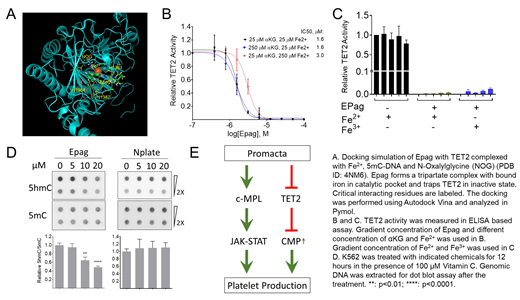
Eltrombopag (Epag) is FDA approved for immune thrombocytopenic purpura (ITP) and aplastic anemia (AA), in which it induces tri-lineage responses in primary and refractory settings. These biologic effects suggest that Epag helps to regenerate not only committed megakaryocytic progenitors, but also hematopoietic stem and progenitor cells (HSPCs). Epag is a small molecule thrombopoietin receptor (TpoR) agonist that activates the JAK-STAT pathway to increase platelet counts similar to the polypeptide based TpoR agonist Nplate. In addition, some of Epag's activity may, unlike that of Nplate, be independent of TpoR. Epag increases HSC self-renewal in mice despite the lack of binding to murine TpoR and showed efficacy in a TpoR-deficient strain. Here we show that Epag binds and inhibits TET2 in an iron-chelation independent manner, to in this way increase precursor expansion.
Since iron is a key prosthetic component of the TET2 enzyme, we determined if Epag sequestration of iron in HSPCs inhibits TET2 function. In silico modeling indicated that Epag can form a tripartate complex with Fe2+, αKG and TET2 (Fig.A). Epag interacted with TET2 via N1387 and H1984 forming a two-way H-bond and also coordinating Fe2+ sandwiched between N-Oxalylglycine a surrogate for aKG and H1381 residues of TET2 (Fig.A). To experimentally confirm the computational structural model and study the effect of Epag on TET2, we used an ELISA-based TET2 activity assay in a cell-free system. We found that Epag inhibits TET2 in a dose-dependent manner with an IC50 of 1.6±0.1 µM in the presence of 25 µM each of aKG and Fe2+ (Fig.B). Interestingly, this observed IC50 of Epag for TET2 inhibition is 10-fold lower than the plasma Cmax of Epag that is produced in humans at standard clinical doses. Therefore, we performed a dose dependent TET2 rescue experiment by increasing aKG and Fe2+. There was no proportional effect on the TET2 inhibitory IC50 of Epag upon increasing either Fe2+ or αKG suggesting the inhibition of TET2 is independent of both these co-factors (Fig.B). This was consistent with in silico structural model data indicating that Epag specifically binds and traps TET2 in an inactive state, explaining why increasing concentration of Fe2+ or Fe3+ failed to rescue TET2 activity (Fig.C). Also consistent with this model of how Epag inhibits TET2, we did not experimentally observe any significant effect of ascorbic acid (100 µM), known to activate TET2 through maintenance of Fe3+↔Fe2+ homeostasis during TET2 catalysis. Underscoring likely relevance of TpoR independent actions of Epag, Epag treatment of K562 cells displaying undetectable levels of TpoR mRNA as well as protein, significantly reduced levels of 5hmC, while Tpo had no effects on 5hmC (Fig.D). We are currently measuring, after written informed consent on an IRB approved protocol, 5hmc levels serially in patients who are receiving Epag.
In summary, we demonstrate TpoR-independent actions of Epag, its direct inhibition of TET2 activity, most likely by locking TET2 in an inactive configuration. Given the fundamental role of TET2 in promoting differentiation, this mechanism-of-action of Epag could be one pathway by which it expands HSPCs, independent of TpoR. In short, Epag creates a transient chemical phenocopy of TET2 loss of function, simultaneously having the capacity to activate JAK-STAT signaling via TpoR. These actions together can explain the clinical potency of Epag.
Nazha:Abbvie: Consultancy; Tolero, Karyopharma: Honoraria; Daiichi Sankyo: Consultancy; Incyte: Speakers Bureau; MEI: Other: Data monitoring Committee; Novartis: Speakers Bureau; Jazz Pharmacutical: Research Funding. Saunthararajah:Novo Nordisk: Consultancy; EpiDestiny: Consultancy, Equity Ownership, Patents & Royalties. Sekeres:Celgene: Membership on an entity's Board of Directors or advisory committees; Millenium: Membership on an entity's Board of Directors or advisory committees; Syros: Membership on an entity's Board of Directors or advisory committees. Maciejewski:Novartis: Consultancy; Alexion: Consultancy.
Author notes
Asterisk with author names denotes non-ASH members.

This icon denotes a clinically relevant abstract


This feature is available to Subscribers Only
Sign In or Create an Account Close Modal